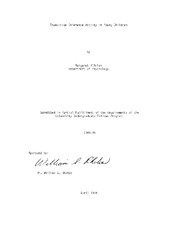| dc.description.abstract | A great deal of controversy surrounds the age of development of logical reasoning as assessed by the ability to make transitive inferences. The purpose of these experiments was to assess transitive inference in young children using a method that was not subject to the alternative interpretations which plague earlier research. In Experiment I, 9 children, with a mean age of 59 months, were tested using a new paradigm, and it was found that the subjects could correctly answer transitive inference questions at a significant rate (p <.04). Experiment II was an attempt to assess a concept underlying transitivity. Specifically, Experiment II assessed the understanding that, in an array A>B>C>D>E, the difference between B and D is greater than the difference between C and D where the relationship between B and D must be inferred. 18 children were tested and were separated into two age groups for the purpose of data analysis. The mean age of the younger group was 55.11 months, and the mean age of the older group was 62.33 months. Results of analyses revealed that older subjects had a significantly greater understanding of the concept being assessed. | en |


